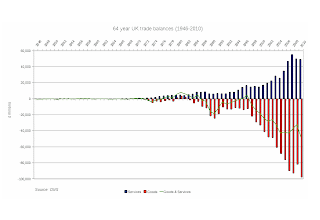High street contraction
Mothercare said it will close 110 stores over the next two years, reducing from 373 to 266. This is around 1/3 of all its shops. This will not be positive for the look of the high street, as the gaps will not be filled. Smaller retailers have already suffered, though it hasn't much made the news. The high-profile large retailers get the headlines, and their ability to suck custom away from smaller businesses (when spending is contracting) softens the impact of that contraction on their business, they report sales up a little or down a little - but at the expence of the smaller businesses whose sales fall so far that the business fails. This is what we would expect in a contracting economy and this is what we are seeing - more and more empty shop fronts.
This is also bad for commercial property companies and other private shopfront property owners as void periods cost a lot, void periods lasting years are fatal. Empty shop fronts are bad for commercial rents - we can see this process in action as Mothercare has already indicated that it will be renegotiating rents on another 40 stores "to a substantially lower level".
The process of reducing the number of retailers will be bad for the consumer and bad for prices. The consumer will be faced with a contracting number of shops to shop in, and the retailers surviving the contraction will try and succeed in raising prices, both because they will try to maintain their margins and profits as their own input prices are presently rising, but also because they can. Fewer retailers means fewer competitors.
This is also bad for commercial property companies and other private shopfront property owners as void periods cost a lot, void periods lasting years are fatal. Empty shop fronts are bad for commercial rents - we can see this process in action as Mothercare has already indicated that it will be renegotiating rents on another 40 stores "to a substantially lower level".
The process of reducing the number of retailers will be bad for the consumer and bad for prices. The consumer will be faced with a contracting number of shops to shop in, and the retailers surviving the contraction will try and succeed in raising prices, both because they will try to maintain their margins and profits as their own input prices are presently rising, but also because they can. Fewer retailers means fewer competitors.


Comments
Post a Comment